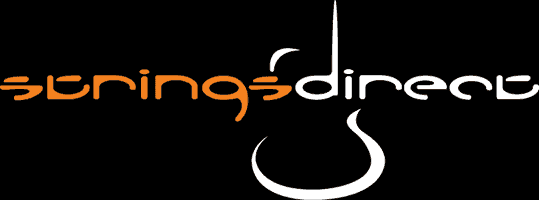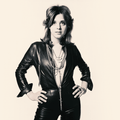DICK DALE
By Strings Direct – 29 August, 2023
PLAYER SPOTLIGHT
"People called me 'King of the Surf Guitar', historians named me 'The father of heavy metal', but I don't care much about stuff like that. It's just Dick Dale music."
D. Dale - Guitar9.com

Over the course of this series we’ve looked at and cross examined so many players, each had their own signature style and approach along with being inspirational pioneers of their craft.
It’s standard to find a guitar player doing something creative with either their string choice or gauge and more so their individual technique. However, to discover a player that’s not only iconic for his standout string gauge and his unique technique, but is also a key figure in the evolution of electric guitar's sonic capabilities is a rare find; I can think of only one other legendary guitar player that springs to mind… (Mr J.M.H 🎸).
This week's spotlight illuminates the “King of Surf Guitar” or even “The father of Heavy Metal”, a gentleman of such talent and depth of musical and creative credibility.
The one of a kind Mr Dick Dale. 🌊 🔊

Mr Misirlou 🏄♂️ 🌊 🎸
The principle of being both revolutionary and dramatically inspirational can surely never be a conscious decision, it must inevitably be a natural movement towards a creative approach envisioned through an individual's eyes.
Let us cast our minds back to 4th May 1937 in Boston, Massachusetts, a significant date when Richard Anthony Monsour graced the Earth. Richard you say, well, the evolution of the man will be further explained as the story develops. 😉
Born to a Lebanese father and a Polish mother Richard was born into culture and diversity from the start of his life which he utilised and proudly carried as a significant influence throughout his musical career.
His musical interest started at a young age when he was 9-years-old and learn to play the piano from his aunt, he then moved on and was given a trumpet during the seventh grade, he then later acquired a ukulele and quickly taught himself the instrument from tutorial books and by mimicking his then idle Hank Williams.
Like many young musicians back then Richard was influenced by his surroundings, his family, and the current musical stars of the time - one interesting influence was his uncle, he told Richard to play the Tarabaki & the Oud. This musical intervention would prove to be a great influence in the years to come and be a catalyst towards a revolutionary style of guitar playing and music.
Another key and very relative influence on Richard was a drummer called Gene Kurpa who played as part of a big band set up.
On reflection when you consider this influence you understand its large contribution to Richard's very individual technique later developed.

As Richard progressed musically he first managed to lay his hands on the guitar when he bought one from a friend for $8 and paid him back in instalments.
It was here that his very interesting approach to musical style began to come through. He attacked the guitar in a way that he learned to play both rhythm and lead parts that filled the place of the drums with a percussive effect.
This approach stemmed back to his Tarabaki knowledge/experience and would go on to further influence his unique rapid alternative picking technique - this would like to be referred to (by Richard) as the “Pulsation”.

As he progressed through his teenage years he continued to play music and the family moved to Southern California as Richard's father had to take a new job in that area; this move really change things.
At the age of 17 he learnt to surf 🏄♂️ 🌊 ...
Combination of a moment-in-time, surroundings, culture, and Richard staying loyal to his roots as a Lebanese-American, and Arabic music continued to inspire him inline with current American culture, this would prove to be fundamental in the creation of a new style of music that was on the brink of entering youth culture at that time.
As he ventured onto the scene musically at about 17-years-old he says he was involved in a big band set up which involved horns and many other instruments - he recalls not being heard much as the guitar was a background instrument. His next project was to move into Country, he wanted to be a country singer. Mostly self taught and with great technique he actually progressed quite well, he managed to secure a gig on the classic West Coast TV show - “Town Hall Party”.
It was a great gig and he played alongside some famous country musicians. He acquired this gig through playing local bars in a Country-Rockabilly band, it's here where we had a chance meeting with Texas Tiny in 1955 who gave him the name “Dick Dale” simply because he thought it would be a great name for a country singer.
It's at this particular moment in time that dick dale was born and Richard Anthony Monsour was transformed. 🎸

Five Ways Dick Dale Changed The Game 🎼
Dick Dale was not only defined by his incredibly individual style of guitar playing but there are many factors which were iconic in his career history that defined and open doors for a new generation to blossom from with their own individuality and creativity.
We're going to look at five defining moments that some people may not be aware of and that are really interesting to not only Dick Dale’s career but defining moments in musical history.

Right Handed Guitar, Left-Side Down 🎸
The first thing you notice about Dick Dale is the fact that he's playing a right-handed guitar left-handed.
This was in one way a 'needs must' situation as much as it was an availability, again this was a great reflection of his personality: a 'get the job done' type of guy.
So what was incredibly odd was the fact that he turned the right-handed guitar upside down to play left-handed but the key point here was that he didn't restring it, so the wound the strings were on the bottom of the fretboard and the plain strings were on the top.
Even after he acquired a standard left-handed Fender Stratocaster he continued to use the reverse stringing method.
This was for a number of factors: he was used to it, he liked it, it gave him an individual style and attack, and also because the bass strings angled differently over the pick ups which gave him more bite and, in turn, warmer sounding treble strings.

The First Man to 100 Watts 🔊
Now a California man, Dick Dale was embedded in the Sun, sea, and sand music scene, when he first met Leo Fender - it truly was a meeting of the minds.
Mr. Fender was renowned for helping out upcoming musicians in a form of collaboration; in one way he would lend out equipment to musicians and want to help them, and secondly as a form of experimentation and real-world situation for his products.
This is encapsulated perfectly in the following overview by Fender on Dick Dale and Leo Fender’s collaboration and journey towards the first hundred watt amplifier.
“In his search for more volume, Dale and Leo Fender found out that the 10-watt amps just wouldn’t cut it after Dale blew several of them up. To remedy this problem, Fender created the first 85-watt transformer, which peaked at 100 watts. As Dale once said, “It was like going from a little VW Bug to a Testarossa.” The amp would later be called the Showman, and paired with a cabinet housing a 15-inch speaker and the Beast, Dale could truly crank things up to 10.
Dale and Fender would continue to work together on upping the ante, building a speaker cabinet that could house two 15-inch speakers to sustain his vicious riffage. Of course, that needed an even bigger transformer, so they teamed with the Triad Company to design a 100-watt version that peaked at 180 watts. Thus, the Dual Showman was born, a revered game-changer.”

Reverb Revolutionary ⛪️
At this time in guitar music tremolo and vibrato - one and the same thing you may say, or some might say maybe not 😉 - along with echo were really the only effects being utilised by many artists and players, but being such an inventive, boundary-pushing innovator Dick Dale was looking for something else.
Inspired by the lush sound of the Hammond organ reverb Dale wanted to see if he could get this onto the stage along with his sound. Initially it began with him getting the effect applied to his voice with the help of his sonic aid Leo Fender. Eventually experimentation meant reverb was added to his guitar sound and there was no going back! The definitive tonal quality and easily recognisable characteristic we now know as the surf guitar sound was born.
“Through some trial and error, Fender channeled this into a pedal that drastically expanded Dale’s tonal options. Where he once slashed and stabbed with his Strat, Dale could now paint with reverb. Famously, this effect was dubbed “wet,” which was all too appropriate for surf rock. The term also captured how the music seemed warm and alive, dripping with colors.
This twin innovation of crushing volume and mind-expanding effects was an immediate sensation in the region. Countless SoCal bands coveted this charged, electric sound, snapping up Stratocasters and offshoots like the Jazzmaster and Jaguar, running them through Fender amps and reverb boxes. “

uniqueguitar.blogspot.com
The Father Of Heavy Metal 🤘
Many people use this comment when referring to Dale outside of the standard “King Surf Guitar” but 'why?' you ask, in what context?
Well this can be subjective from a number of angles... initially I would think that his aggressive, alternative, extremely fast picking style could be a nod to today's modern heavy-metal playing along with his outrageous drive to get things louder and pushing towards the design of the 100W amplifier. You sort of think without his urge to do this we may not have large, full-scale 4x12" 'head and cab' hard-rocking situations present on many stages.
Renaissance via Tarantino
Arguably one of the biggest and most recognisable riffs of the 90's was actually from the 60’s.
The 1994 iconic cult movie by Quentin Tarantino 'Pulp Fiction' was a commercial and critical success and is considered one of the greatest movies ever made to this day. Opening credits had a mind-blowing soundtrack and a riff that blew the minds of a new generation! 😎
People now strongly associate this song and the film together but we learn hear from Dick Dale himself that the inspiration of the film could have been via the song in many aspects.


Strings To Surf 🏄♂️ On 🌊
As we have discovered Dick Dale is by no means a standard guitar player or a standard artist but somewhat of a revolutionary in every form, so what makes you think his string choice is going to be off the shelf 😉
So we spoken about him being the father of heavy metal, well, heavy metal is what we find here attached to his beloved Stratocaster.
“Dale’s battle-worn gold Stratocaster, nicknamed “the Beast”, was outfitted to be played loud, as it boasted massive .016-, .018- and .020-gauge unwound strings and .039-, .049- and .060-gauge wound strings that produce tremendous tension. When on stage, Dale didn’t necessarily break strings—he practically burned through them, thanks in part to the heavy picks he used. The Beast did not have any tone controls, only a master volume and a toggle that bypassed the three-way switch to activate the neck and middle pickup only.”
Via fender.com
What an iconic player to discover so much history behind him so much individuality & creativity and instantly recognisable icon that will live forever. ✌️
* * * * *
REFERENCES
https://www.newyorker.com/culture/postscript/dick-dale-the-inventor-of-surf-rock-was-a-lebanese-american-kid-from-boston
https://www.surfer.com/features/surf-rock-godfather-dick-dale-passes-away-at-81/
https://www.phawker.com/2012/07/16/lord-of-the-strings-qa-with-dick-dale/
https://www.fender.com/articles/artists/the-father-of-surf-7-essential-dick-dale-facts
https://pitchfork.com/thepitch/how-dick-dale-changed-the-sound-of-rock-guitar/#main-content
https://uniqueguitar.blogspot.com/2019/03/dick-dale-his-guitar-and-amplifier-and.html






